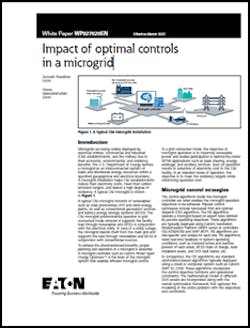Many commercial and industrial businesses are installing microgrids in order to lower their energy costs, reduce their carbon emissions and bolster their resilience. These benefits are largely achievable because of the microgrid controller that manages the use of distributed energy sources such as wind, solar, battery energy storage systems and the grid. When it comes to microgrid control strategies, there are two common approaches — rule-based (RB) and optimal dispatch (OD). Optimal controls are generally more effective than the rule-based approach, but they have more data input requirements.
In this white paper, you’ll learn how greater economic, resilience and sustainability objectives can be achieved through the use of optimal dispatch control strategies.
The authors provide real-world examples illustrating how the optimal controls approach is superior to a rule-based approach. A use case shows how optimal dispatch helped the Eaton manufacturing facility in South Africa achieve a greater reduction in its electricity costs than could have been found with a rule-based approach. Examples are also provided showing how optimal controls can deliver greater resilience and carbon emissions reductions.
